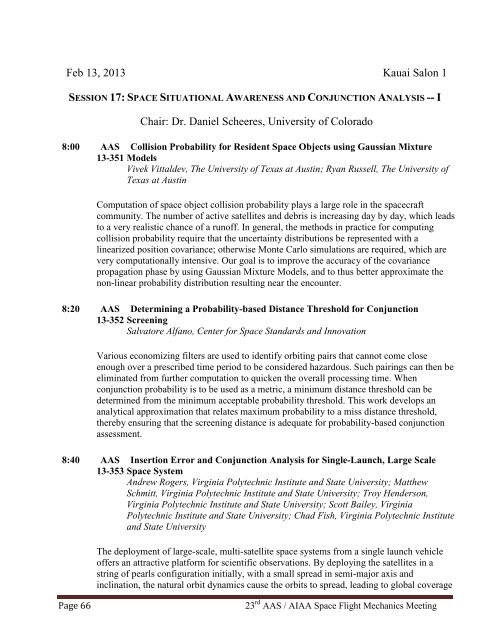meetings - Space Flight Mechanics Committee
meetings - Space Flight Mechanics Committee
meetings - Space Flight Mechanics Committee
Create successful ePaper yourself
Turn your PDF publications into a flip-book with our unique Google optimized e-Paper software.
Feb 13, 2013 Kauai Salon 1<br />
SESSION 17: SPACE SITUATIONAL AWARENESS AND CONJUNCTION ANALYSIS -- I<br />
Chair: Dr. Daniel Scheeres, University of Colorado<br />
8:00 AAS Collision Probability for Resident <strong>Space</strong> Objects using Gaussian Mixture<br />
13-351 Models<br />
Vivek Vittaldev, The University of Texas at Austin; Ryan Russell, The University of<br />
Texas at Austin<br />
Computation of space object collision probability plays a large role in the spacecraft<br />
community. The number of active satellites and debris is increasing day by day, which leads<br />
to a very realistic chance of a runoff. In general, the methods in practice for computing<br />
collision probability require that the uncertainty distributions be represented with a<br />
linearized position covariance; otherwise Monte Carlo simulations are required, which are<br />
very computationally intensive. Our goal is to improve the accuracy of the covariance<br />
propagation phase by using Gaussian Mixture Models, and to thus better approximate the<br />
non-linear probability distribution resulting near the encounter.<br />
8:20 AAS Determining a Probability-based Distance Threshold for Conjunction<br />
13-352 Screening<br />
Salvatore Alfano, Center for <strong>Space</strong> Standards and Innovation<br />
Various economizing filters are used to identify orbiting pairs that cannot come close<br />
enough over a prescribed time period to be considered hazardous. Such pairings can then be<br />
eliminated from further computation to quicken the overall processing time. When<br />
conjunction probability is to be used as a metric, a minimum distance threshold can be<br />
determined from the minimum acceptable probability threshold. This work develops an<br />
analytical approximation that relates maximum probability to a miss distance threshold,<br />
thereby ensuring that the screening distance is adequate for probability-based conjunction<br />
assessment.<br />
8:40 AAS Insertion Error and Conjunction Analysis for Single-Launch, Large Scale<br />
13-353 <strong>Space</strong> System<br />
Andrew Rogers, Virginia Polytechnic Institute and State University; Matthew<br />
Schmitt, Virginia Polytechnic Institute and State University; Troy Henderson,<br />
Virginia Polytechnic Institute and State University; Scott Bailey, Virginia<br />
Polytechnic Institute and State University; Chad Fish, Virginia Polytechnic Institute<br />
and State University<br />
The deployment of large-scale, multi-satellite space systems from a single launch vehicle<br />
offers an attractive platform for scientific observations. By deploying the satellites in a<br />
string of pearls configuration initially, with a small spread in semi-major axis and<br />
inclination, the natural orbit dynamics cause the orbits to spread, leading to global coverage<br />
Page 66<br />
23 rd AAS / AIAA <strong>Space</strong> <strong>Flight</strong> <strong>Mechanics</strong> Meeting
















